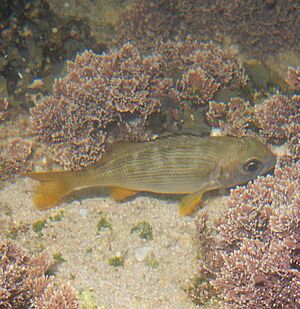White musselcracker facts for kids
Quick facts for kids White musselcracker |
|
|---|---|
 |
|
| Conservation status | |
| Scientific classification | |
| Synonyms | |
|
Species synonymy
|
The white musselcracker is a type of fish known by many names, like musselcracker seabream or just cracker. Its scientific name is Sparodon durbanensis. This fish is the only species in its group, called a genus, named Sparodon.
A French scientist, François Louis Nompar de Caumont de Laporte, comte de Castelnau, first described this fish in 1861. The white musselcracker is a good fish to eat. It is an important food source in southern Africa.
Contents
Discovering the White Musselcracker
The Sparodon group was first named in 1938. This was done by a South African fish expert, James Leonard Brierley Smith. He named it after its only species, Sargus durbanensis.
The fish Sargus durbanensis was officially described in 1861. This was by the French scientist Francis de Laporte de Castelnau. He found the first fish in Durban, South Africa. The white musselcracker belongs to the Sparidae family of fish.
What's in a Name?
The name Sparodon comes from two parts. "Spar" is from the fish family name, Sparidae. "Odon" means "tooth" in ancient Greek. This name points to the fish's special teeth.
It has four front teeth in each jaw that look like human incisors. The two middle teeth in each jaw are larger and curved. The second part of its name, durbanensis, tells us where it was first found. This was in Durban, South Africa.
What Does the White Musselcracker Look Like?
The white musselcracker, S. durbanensis, can grow quite large. It can reach up to 120 centimeters (about 47 inches) long. It can also weigh around 22 kilograms (about 48 pounds).
Its body and head are usually silver or gray. Its fins are darker, and its belly is white. This fish has very strong jaws and large teeth. These features help it to easily eat its prey.
Its body shape is like a long oval. The depth of its body is about 2.5 to 3 times less than its total length. It has a line of scales along its side, called the lateral line. This line has between 58 and 61 scales. The area between its eyes has no scales.
The fin on its back, called the dorsal fin, has 11 strong spines. It also has 11 or 12 soft rays. The fin on its underside, called the anal fin, has 3 spines and 10 soft rays.
White Musselcracker Behavior and Life Cycle
Young white musselcrackers usually live in shallow reefs. They stay in waters no deeper than 12 meters (about 39 feet). Some adult fish may travel north-east during certain seasons.
The time between two generations of these fish is about 13 years. Young fish usually lay their eggs, or spawn, from August to January. White musselcrackers can live for about 31 years. They are ready to have their own young when they are about 5 and a half years old.
S. durbanensis eats many different small sea creatures. These include sea urchins, crustaceans like crabs, and gastropods like snails. They also eat bristle worms. Sometimes, they even eat a type of green algae.
Where They Live and How They Are Protected
The white musselcracker lives in the South-east Atlantic Ocean. Most of them are found near Southern Africa. They have not been seen further north than the KwaZulu-Natal province.
They prefer warm, shallow coastal waters. They can live in depths of up to 80 meters (about 262 feet). The number of white musselcrackers is currently going down. Because of this, the IUCN lists them as "Near Threatened."
Many efforts are being made to protect them. One important rule limits people to catching only two fish per day.


